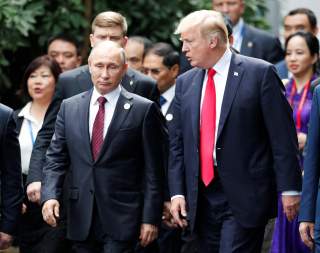Great Power Summits: Risky, But Necessary
Summits are risky, but necessary, instruments of state policy. They are not supposed to exist primarily to serve public relations events or to generate television specials. So, what happens in Helsinki?
“There’s no need for a summit,” the president’s critic wrote, “and meeting Putin would probably cause more problems than it can solve. We have to let go of the stereotypically American idea that personal meetings are always useful.”
Another caution to Donald Trump to stay away from being entangled in Vladimir Putin’s web? No. I wrote these words in 2015, advising Barack Obama not to be lured into a pointless meeting with the Russian president. Obama eventually met with Putin in the background of a G20 meeting, resolving little but at least doing no further harm to U.S. interests.
Here we are again. This time, President Trump has decided to charge ahead, and meet Putin in Helsinki. His team is in danger of stepping into every trap that faced Obama – particularly the constant hazards presented by a summit without a firm agenda – but Trump seems determined to make talking to Putin as dangerous as possible.
It is hardly new to note that President Trump is impulsive and has an outsized faith in his own ability to sway others in a personal meeting. Repeated failures on this score, however, including the disastrous G7 meeting in Canada, have had no effect on this self-confidence. His summit with North Korean dictator Kim Jong Un went about as badly as possible, with Kim emerging not only a leader the equal of the President of the United States, but with no obligations other than to maybe, perhaps, talk about his nuclear program at some point in the gauzy mists of the future.
Putin wants a summit for the same reason that Kim wanted one. He is a trained intelligence officer who does nothing for any reason but self-interest. Like other foreign leaders, his intelligence agencies have studied the American president, and the Russians know what everyone else knows: that Trump is susceptible to flattery, loves televised spectacles, and has a tendency to escalate his praise, promises, and concessions when he is feeling happy and expansive.
Even if we leave aside Trump’s manifest weaknesses as a negotiator, why would any U.S. president meet with Putin at this point? Is there any reason a summit might be a good idea? Not really.
Summits are usually the result of negotiation, in which the principals meet to put their final imprimatur on important issues that have mostly been worked out by professional diplomats earlier in the process. On occasion, they are useful for getting two leaders together to untie a knot that requires their personal attention, or to make commitments that lower-level officials are not empowered to offer.
When Richard Nixon met Mao Zedong, for example, only the two leaders could finally agree to normalize relations, despite the careful groundwork laid by Secretary of State Henry Kissinger. Jimmy Carter invited Israeli and Egyptian leaders to Camp David not to enjoy the limelight, but to escape it, and to negotiate personally without the distractions of publicity.
More typical are the summits between leaders that occur after a lot of legwork. Successful examples are the culmination of arms agreements, such as the SALT process of the 1970s or the 1987 summit between Mikhail Gorbachev and Ronald Reagan to sign a treaty banning intermediate range nuclear weapons in Europe.
When summits have no agenda, they can go wrong. The first meeting between Reagan and Gorbachev produced grim handshakes in the cold, and little more. Gerald Ford went to Vladivostok in 1974 and returned with items that ended up in a treaty that was never ratified.
The Helsinki meeting risks all of these problems and more. Putin knows what he wants: the American legitimization of his conquests in Ukraine, the subsequent increased discord this will produced between the United States and its European allies, and the end of sanctions against the Kremlin for its execrable behavior.
Trump, for his part, wants…well, no one is quite sure what he wants, other than another summit that will generate the sugary diplomatic high the president apparently experienced after meeting Kim in Singapore. National Security Adviser John Bolton has gone to Moscow, but his remit is unclear, and in any case, Trump has shown that advance work means nothing in an administration where policy could be made in a matter of seconds from a tweet or an offhand comment.
Summits are risky, but necessary, instruments of state policy. They are not supposed to exist primarily to serve public relations events or to generate television specials. It is now too late to stop this terribly ill-advised summit with the Russians, but we can hope, at the least, that the president’s staff will attempt – and this will likely require a team effort of immense energy – to prevent any meetings with Putin in the absence of senior administration members, or to forestall the dreaded tweet or unscripted moment that upends 75 years of American diplomacy.
The stability of the U.S. alliance system and the peace of Europe is at stake. This summit is a needless and self-inflicted risk, but we have bought the ticket, and we must now take the ride.
Tom Nichols is a professor at the Naval War College and the Harvard Extension School, and the author of “The Death of Expertise.” The views expressed here are entirely his own.

